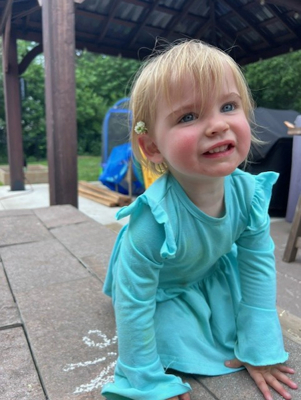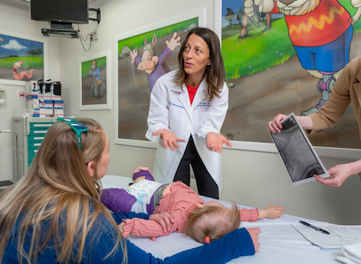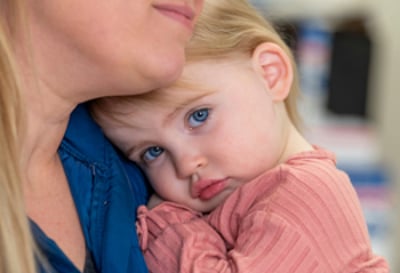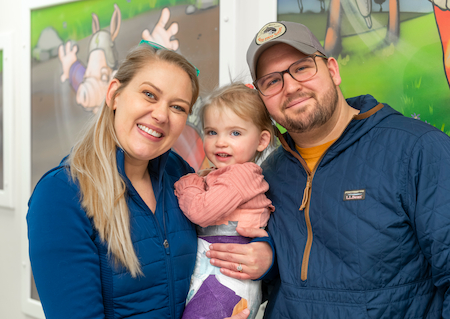Hip Dysplasia: June’s Story
Meet June

If you’ve ever tried to keep a toddler still when they just want to be on the move, you can imagine how parents Julianne and Cody felt when they learned their almost 2-year-old daughter, June, would need to be in a body cast for 6 weeks. But with patience, dedication and a lot of support from friends and family, June has now graduated from the cast to a brace — just in time for summer fun.
At 17 months old, June was diagnosed with hip dysplasia, a condition where the long bone in the upper leg (femur) doesn’t fit correctly into the hip socket. This can lead to difficulties with walking and other movement, as the hip dislocates more easily and causes one leg to be shorter than the other.
“Last fall, we noticed she had a little bit of a limp,” Julianne said, “so we got some X-rays done. Our pediatrician suspected hip dysplasia and referred us to Dr. Berglund.”
Like father, like daughter
Julianne and Cody were familiar with hip dysplasia because Cody had the same problem when he was a toddler. He had a body cast at 2 and then ended up needing a full hip replacement in his early 20s.
Pediatric hip specialist Lisa Berglund, MD, was impressed by the family’s positive attitude toward June’s diagnosis. “When I first met June and her family, they already knew more than most families because of Cody’s childhood experience,” Dr. Berglund recalled.
“They were emotional that first visit, but by the time they left, they were like, ‘Let’s do this! Let’s get this surgery scheduled!’ They came full circle that visit, and by the time we saw them at their first post-op appointment, they were all smiles and had embraced the challenge of the surgery and recovery.”
4 hours of surgery, 6+ weeks of recovery

June’s treatment plan included a 4-hour surgery. First, Dr. Berglund and her team would reposition the left hip in the hip socket, then perform an osteotomy (bone cut) to reshape the hip socket to improve the alignment. After surgery, the team applied a full-body cast called a spica cast that holds the hip in the correct position during recovery.
“The spica cast can be very intimidating for parents, because it’s basically a body cast that their child can’t move in, which is tough for a very active toddler,” Dr. Berglund explained. “We talk through everything with the family and give them lots of support and resources. The kids usually get adjusted within a few days, but for the parents, it can really upend their life,” she shared.
“It’s definitely a hard situation,” Julianne said, “but in the end, it’s fixable, and she’s going to be ok. We researched all the best hip surgeons in Missouri, and Dr. Berglund had the highest ratings. We trusted her because she knew exactly what to do to fix June’s hip and explained everything in non-medical terms so we could understand it.”
Finding support all around
Julianne and Cody have found a great community of support through a local Facebook page for families of kids with hip conditions. They share advice, resources and even specialized equipment like strollers and beanbag chairs that make life in a spica cast a little easier for families.
“My advice for other families in our situation is to really take the time to look things up, ask questions and understand the condition,” Julianne said. “It helped me to know that as a parent, I didn’t do anything wrong.”
The Hip Program team helps families anticipate and address all aspects of their child’s life with a hip condition, including their mental and emotional wellbeing. “We have such an awesome team,” said Dr. Berglund. “We have nurses in the clinic fielding questions and an amazing cast tech who can fix issues with the cast so we don’t have to change it in the operating room. Our OR and inpatient teams are amazing, too. Everyone really cares about these families.”
Life with a cast: a balancing act

Julianne and Cody have juggled childcare for June and their 3-year-old son, Max, since a typical daycare center is not always equipped to handle a child in a full-body cast like June had. Max struggled to understand why June needed so much additional care, so they enlisted family and friends to take him out to do fun things while June was in the cast.
As for June, she has shown resilience throughout the process, Julianne said. “Before she was in the cast, she was into everything. She loved to color but would even try to eat the crayons!” Lately, though, she has really come into her own and loves to play with their cat, Billy, and all kinds of animals. June loves to be outside and active; her mom calls her a “barefoot kid.” Her parents are thankful that they were able to get her cast off at the beginning of the summer so she can run around and play with her friends.
Next steps for June

“June has so many years of growth yet,” said Dr. Berglund. “We come into a surgery like hers hoping it is her one and only hip surgery, but we will continue to monitor her as she grows.” Dr. Berglund shared that the hip team’s goal for all their young patients is "to set them up with a healthy hip that will last them all through adulthood.”
